The Great War Centenary: The Last Post
By 1917, the horrors of trench warfare had been experienced by millions of young men who had lived and died there. But even with the all the killing, the First World War was no nearer resolution. More horror was to follow but, at last, peace was no longer an abandoned dream.
This is Part Seven of a series of posts leading up to the centenary of the end of The Great War on November 11, 2018. For details of trench warfare and the great battles that were fought from them, please see The Great War Centenary: Part Six, The Trenches.
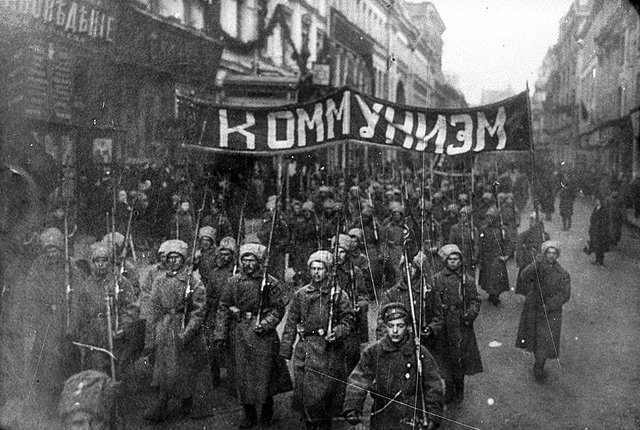
Armed Russian soldiers carry a banner reading “Communism”
Russian Revolution
The Russian Revolution of 1917 effectively ended Russia's participation in World War One. It started with protests and riots mainly about living conditions and poverty. This was directly caused by the war with Germany on the Eastern front, and the blockade by the Ottomans on the Black Sea. This gave rise to the Bolsheviks party who overthrew the Tsarist government in October 1917. In December, the new government reached an Armistice agreement with the Germans and ceded Poland, Ukraine and other territories to the Germans. This relieved a great deal of the pressure of the Allied North Sea blockade, particularly in supplying food to a starving population.
About 5.5 million out of Russia's 16 million soldiers were killed and wounded. This was less than Germany and France. But this figure does not include 500,000 soldiers missing, 3 million prisoners of war, 1.1 million disabled, 6 million refugees and tens of thousands of civilian victims. The losses were unbearable to the population, a significant factor when considering the losses in the civil war, which claimed more Russian lives than had the World War.
Passchendaele
On the Western Front, the war raged on. The frontline had inched forward and by July 1917 had reached Flanders.
David Lloyd George, the British Prime Minister, contrived to appoint the French General Nivelle as supreme war commander over the British commander Field Marshal Douglas Haig. Haig was assured that the appointment was for one operation only and that if he felt the British army was being misused by the Frenchman he could appeal to the British government.
After a disastrous campaign, Nivelle was relieved of his duties and replaced by the “Saviour of Verdun”, General Petain. Petain thought any offensive in the Ypres area in Belgium would be foolhardy.
Haig disagreed with Petain who had wanted to withdraw away from the German lines. Haig was given the go-ahead to attack the Germans, on condition that if the opening phase of the operation was not a success, he would withdraw.
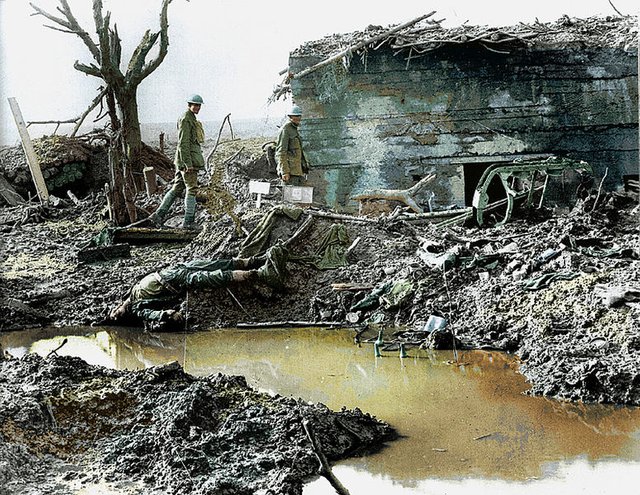
Battle of Passchendaele
This operation was the Third Battle of Ypres (July to November 1917), later known as “Passchendaele” — after a village that came to be the campaign’s final objective. Haig broke his promise and continued the attack after the initial operations failed. The conditions were horrific. It was unseasonably wet, in what is normally a very marshy area. Mud was everywhere, making transport of weaponry and men very difficult. Thousands of men and horses drowned in the muddy shell holes. As casualties mounted, Haig poured more men into the battle in what looked to the world as utter futility. Lloyd George writing in 1938 said:
Passchendaele was indeed one of the greatest disasters of the war ... No soldier of any intelligence now defends this senseless campaign ...
The official figures put British casualties at 244,897 and estimated German losses of at 400,000.
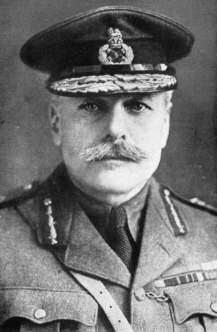
Field Marshal Douglas Haig
Haig was nicknamed “Butcher Haig” for the two million British casualties endured under his command.
Hundred Days Offensive
On 17 July 1918, the war had come full circle. The Allies had seen off another German offensive at the Marne, just like at the start of the war almost 4 years before that.
The Allies, under Allied supreme commander Ferdinand Foch, ordered a counter-offensive which became known as the Second Battle of the Marne. It commenced with an enormous artillery barrage over a wide front from the Marne to the Aisne rivers. Then 350 French tanks rolled over the German lines followed by infantry divisions - including the first American division to have action in the war and which spearheaded the French onset. At first, they were met with little resistance but on 29 July the Germans had rallied, inflicting some heavy losses on the American forces. But by 5 August, the Germans withdrew and the battle was over.
News of this victory did little to cheer the British, where hopes had been dashed too often and the country beset by strikes. Critical voices emerged from Germany too.
By early August, the British forces had enjoyed two months of comparative quiet. The time had been used to transform the British forces with better training, better weaponry and better organisation. It was now a new type of war, out of the trenches, mobile.
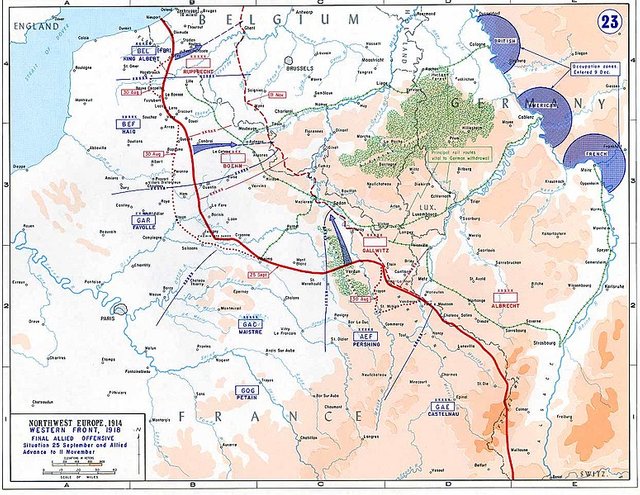
The Allies, under Field Marshal Haig, had planned a new offensive. The big difference between this and the ones before it was that it was conducted in total secrecy. While the Germans were back in Berlin planning their own offensive, a huge force of Australian, Canadian, British and French forces — and more than 500 tanks — was assembled. The Royal Air Force (RAF) had been formed and it had a vital role in the operation, in bombing bridges and supply lines.
On 8 August 1918, to the total surprise of the Germans, the Battle of Amiens commenced. Instead of the usual artillery bombardment, the attack was led by 400 tanks moving over the German lines. Rapid progress was made with the Australians and Canadians making the deepest advance and taking 15,000 Germans captive that day. The RAF took a beating from the Germans, losing 100 of its 800 aircraft.
The troops found themselves back in the Somme — the dreaded killing fields. But the battle was won. It took away the initiative and resolve of the German forces, and morale amongst their troops dropped.
General Ludendorff, chief of the German forces, said the war must end. The Kaiser backed him on this. Austria too had realised that its fate rested with Germany and called for peace. Bulgaria and Turkey too needed peace.
But the Allies realised peace was a distant vision and there was still much work to be done. The French and British widened the front and had great success with their advance, winning battle after battle. By mid-October 1918 the Allies recovered almost all of German-occupied France and part of Belgium.
However, there was still one major obstacle for the Allies to clear before there could be any chance of peace: the Hindenburg Line had to be overcome. This was a German defensive position built during the winter of 1916–1917 on the Western Front. It was the German last line of defence and the Allies expected it to be defended vigorously. It required the entire Allied force and, for the first time, the Americans with an army in their own right.
The first battle to breach the line finished on 27 September. As expected the Germans fought back even though they were dispirited. The Allies pushed the Germans right back beyond the Hindenburg line by early November.
The Hundred Days Offensive brought victory, but at a huge cost. Allied casualties between August and November 1918 were around 700,000. German casualties were slightly higher at around 760,000.
Initially, the Allies had not expected the offensive to end the war and were planning their final attack for the Spring of 1919. However, their impressive victories during the Hundred Days Offensive broke the spirit of the German Army and inflicted losses from which they could not recover.
A greater enemy
In 1918 the world was struck by Spanish flu, a pandemic that wiped out up to 100 million lives. That is far more lives than lost in the Great War itself. A fifth of the world's population was infected. The flu was most deadly for people aged 20 to 40, making it even more damaging.
It is very likely that it was the war that allowed the virus to spread. The war caused the massive movement of people, both military and civilian which could cause it to spread to almost all corners of the earth. Recent research has shown that the virus could have been a type of bird flu.
Germany suffered some 1 million deaths from Spanish Flu, the highest toll of any country. This was followed by other European countries: Italy 8.3 million, France 600,000, Spain 570,000 and England and Wales 430,000.
Spanish Flu affected the outcome of the War since it destroyed the morale of troops when they heard that their families were dying back home.
“Negotiations”
By October 1918 the German position was hopeless. The German leaders had come to accept that the war could not be won. But what sort of peace did it want?
In January 1918 US President Woodrow Wilson presented the “Fourteen Points” proposal for “peace without victory”. But by October 1918, American troops had suffered great losses by the Germans and the idea of peace without victory was not something the American people would accept.
However, the German government approached the United States with a request for an armistice based on that proposal. But the Allies had selected their commander-in-chief, Ferdinand Foch, to conduct all armistice negotiations.
Foch effectively required a German surrender. He made sure that there would be no possibility of Germany continuing the war. The agreement was imposed on Germany — there was no real negotiation.
The agreement has been criticised as laying the foundations of future conflicts — most notably World War Two. But historians argue that the conditions were not unduly harsh. Rather, the agreement contained compromise solutions to difficult problems, limiting their long-term success.
German Revolution
During the night from 28 to 30 October 1918, some crews of the German fleet refused to obey orders. Sailors on board three ships from the Third Navy Squadron refused to weigh anchor. Some committed outright mutiny and sabotage.
The mutinous crews were subdued when cannons were pointed at them. Nevertheless, the naval command had to drop its battle plans as it was felt that the crew's loyalty could no longer be relied upon.
Within days, this revolt spread right across the country and led to the proclamation of a republic on 9 November 1918 and to the announcement of the abdication of Kaiser Wilhelm II.
The abdication of Kaiser Wilhelm II and the formation of a democratic government in Germany were requirements of the armistice agreements. But the generals ensured that the new Socialist government was tarnished with the humiliation of the defeat for which they themselves were responsible.
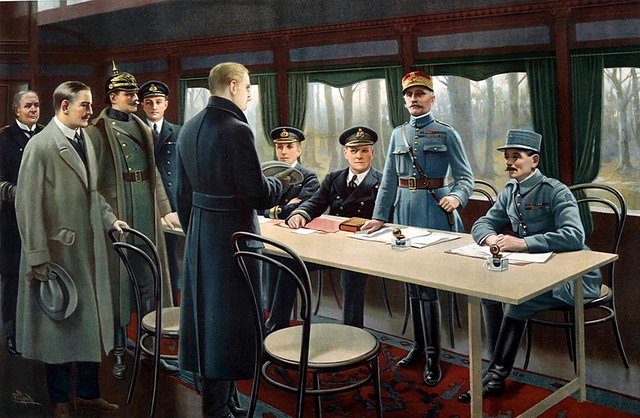
Signing
The Armistice was the result of a hurried and desperate process. The German delegation headed by Matthias Erzberger crossed the frontline in five cars and was escorted for ten hours across the devastated war zone of Northern France, arriving on the morning of 8 November. They were then taken to the secret destination aboard Ferdinand Foch's private train parked in a railway siding in the forest of Compiègne.
The Germans were handed the list of Allied demands and given 72 hours to agree. There was no question of negotiation. The Germans were able to correct a few impossible demands (for example, the decommissioning of more submarines than their fleet possessed), extended the schedule for the withdrawal and registered their formal protest at the harshness of Allied terms. But they were in no position to refuse to sign.
The Armistice amounted to complete German demilitarisation, with few promises made by the Allies in return. The naval blockade of Germany was not completely lifted until complete peace terms could be agreed upon.
On Sunday 10 November, they were shown newspapers from Paris with the news the Kaiser had abdicated. That same day, the new Chancellor, Friedrich Ebert, instructed Erzberger to sign. The cabinet had earlier received a message from Hindenburg, requesting that the armistice be signed even if the Allied conditions could not be improved on.
The Armistice was agreed upon at 5:00 a.m. on 11 November, to come into effect at 11:00 a.m. Paris time (noon German time). Signatures were made between 5:12 a.m. and 5:20 a.m., Paris time.
Hence the occasion is often referred to as “the eleventh hour of the eleventh day of the eleventh month”.
At precisely that time, the guns fell silent. The war was over.
The last post
Today, the 11th November 2018, marks the centenary of the signing of the Armistice. People gathered at memorial sites all around the world, not to celebrate, but to honour the fallen.
The millions of people who died — teenaged sons, fathers, brothers, mothers and sisters from all walks of life, from all the countries that took part on either side — deserve the respect and honour of those who came after them. They didn't choose to die in those rat-infested trenches. Nor to drown in toxic slime after being ripped apart by a shell. Nor to choke to death from poison gas. They were real people, with their own hopes and dreams, with families who loved them and who were heartbroken at their loss.
So today we remember them. The Last Post is sounded on a bugle when the sun goes down and all the business for the day is done.
At Ypres, the site of Passchendaele, the Last Post ceremony takes place every single day. After the bugles are blown, wreaths are laid in honour of the fallen.
They shall grow not old, as we that are left grow old:
Age shall not weary them, nor the years condemn.
At the going down of the sun and in the morning,
We will remember them.
This concludes the series on World War One
Previous posts in this series:
The Great War Centenary: Introduction
The Great War Centenary: Part One, The Tinderbox
The Great War Centenary: Part Two, The Spark
The Great War Centenary: Part Three, Invasion
The Great War Centenary: Part Four, Ottomans and Gallipoli
The Great War Centenary: Part Five, The East and At Sea
The Great War Centenary: Part Six, The Trenches
References:
https://encyclopedia.1914-1918-online.net/article/war_losses_russian_empire
https://www.bl.uk/russian-revolution/articles/timeline-of-the-russian-revolution
https://encyclopedia.1914-1918-online.net/article/war_losses_russian_empire
https://www.forces.net/news/passchendaele-britains-most-controversial-ww1-battle
https://en.wikipedia.org/wiki/Battle_of_Passchendaele
https://en.wikipedia.org/wiki/Douglas_Haig,_1st_Earl_Haig
https://www.iwm.org.uk/history/from-amiens-to-armistice-the-hundred-days-offensive
https://www.history.com/topics/world-war-i/amiens-battle-of
https://www.thecanadianencyclopedia.ca/en/article/battle-of-amiens
http://www.worldwar1luton.com/event/hundred-days-offensive
https://en.wikipedia.org/wiki/Hundred_Days_Offensive
https://en.wikipedia.org/wiki/Hindenburg_Line
https://www.theguardian.com/world/2018/sep/09/spanish-flu-pandemic-centenary-first-world-war
https://www.iwm.org.uk/history/the-peace-treaties-that-ended-the-first-world-war
https://en.wikipedia.org/wiki/Armistice_of_11_November_1918
http://www.greatwar.co.uk/events/menin-gate-last-post-ceremony.htm#originlastpost
Also posted on Weku, @tim-beck, 2018-11-12
👍
An extraordinary conclusion to a masterful series. Thank you for closing with the Last Post.
Thank you for your kind words, @kiligirl
This post was shared in the Curation Collective Discord community for curators, and upvoted and resteemed by the @c-squared community account after manual review.
@c-squared runs a community witness. Please consider using one of your witness votes on us here
After being wrecked by war to suffer Spanish Flu hitting the world I had forgotten that detail. How quickly one forgets struggles people valiantly fought for to make a better world.
Sad to think how many wars have been raged, with little thought to loss of life, another persons feelings.
Thank you for this wonderful series, reminder of what transpired @tim-beck
Thank you @joanstewart. I've spent so much time pouring over the photographs of the young men in the trenches that I've feel I got to know them - on all sides. On Sunday @kiligirl and I saw the wonderful Peter Jackson movie, They Shall Not Grow Old, and there they were in full colour with shells exploding around them. Shew!
Not sure how many movies and books I have read on WW2, you do tend to be drawn into the past. The misery, bravery, hardship people endured, something the youth need to know, it is world wide history.
Congratulations! Your post has been selected as a daily Steemit truffle! It is listed on rank 3 of all contributions awarded today. You can find the TOP DAILY TRUFFLE PICKS HERE.
I upvoted your contribution because to my mind your post is at least 11 SBD worth and should receive 196 votes. It's now up to the lovely Steemit community to make this come true.
I am
TrufflePig, an Artificial Intelligence Bot that helps minnows and content curators using Machine Learning. If you are curious how I select content, you can find an explanation here!Have a nice day and sincerely yours,

TrufflePigThanks for this kind of historical look back to such a momentous event that marked history and lead up to even a larger turning point for humanity through bloodshed and conflict.
You're welcome, @trinumedia
Thank you for putting together this lesson on that awful war. My grandfather was in France and never talked about it. I can't imagine the horrors he saw as a teenager.
Yes, it is unimaginable. If you ever get the chance, see Peter Jackson's film They Shall Not Grow Old. It's very enlightening to hear the actual views of the soldiers brought back to life.
I didn't realize it had been released. I remember seeing a clip of one of the lip readers talking about how she had translated what was being said in some of the old clips and I knew it was something that I wanted to remember to see. Thanks for the reminder.
We saw it on Sunday. There were only two screenings. I'm not sure when/if it will be on again, but it's probably available on streaming/TV.
I looked and didn't find it on Amazon or Netflix, but it will be there evenrually, I'm sure!
howdy there tim-beck! wow when you think about the price paid in that war and look at the stunning numbers dead or injured it's breath taking and heart breaking!
But good job of educating about it because people need to remember and never repeat!
Thanks, @janton